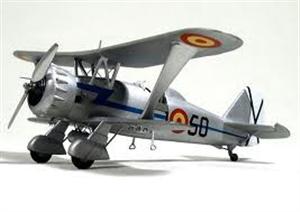Henschel Hs-123
The single-seat dive bomber/ground support Henschel Hs-123 was designed in 1933, and entered Luftwaffe service in 1936. Powered by a 880-hp BMW 132 Dc nine-cylinder radial engine, it had a maximum speed of 345 km/h (214 mph) and a range of 850 km (530 miles). The biplane had an empty weight of 1,504 kg (3,316 lbs), a length of 8.3 m (27 ft 4 in), a height of 3.2 m (10 ft 6.5 in) and a wingspan of 10.5 m (34 ft 5.5 in). Its armament was two 7.92-mm Rheinmetall MG 17 machine guns located in the nose between the engine and the open cockpit. Four 50-kg (110-lb) bombs were carried in racks under the lower wing. About 265 units were produced, of which most were version Hs 123 A-1. A batch was sold to China in 1938 and some were sent with the German Legion Condor to fight in the Spanish Civil War between 1936 and 1939.
At the outbreak of World War II, the Henschel Hs 123 was replaced by the legendary Junkers Ju 87 in the Stuka role, but—although outdated—it remained the last operational biplane used by the Luftwaffe, apart from some trainers and floatplanes. It was used with great success in a close-support role during the campaign of Poland in 1939, and in Holland and France in 1940.
 The Hs 123 was able to give strafe and bomb with great accuracy despite the lack of any radio link. It could survive a lot of antiaircraft punishment, and by virtue of careful setting of the propeller speed, it could produce a demoralizing screaming noise. Although representing a class of aircraft generally regarded as obsolete, the trim little biplane continued front-line service, especially on the Russian front. Such was its value that it was suggested that the aircraft should return to production in 1943. The suggestion was declined, but the existing Hs 123s continued in combat service until mid–1944 when all of them were destroyed in operation. For an oldfashioned biplane with fixed landing gear and open cockpit to be serving with frontline units in 1944 must seem anachronistic, but the Henschel Hs 123 established a good reputation for its maneuverability, reliability, sturdiness, robustness, and ability to operate in conditions that modern, sophisticated aircraft found too harsh to withstand.
The Hs 123 was able to give strafe and bomb with great accuracy despite the lack of any radio link. It could survive a lot of antiaircraft punishment, and by virtue of careful setting of the propeller speed, it could produce a demoralizing screaming noise. Although representing a class of aircraft generally regarded as obsolete, the trim little biplane continued front-line service, especially on the Russian front. Such was its value that it was suggested that the aircraft should return to production in 1943. The suggestion was declined, but the existing Hs 123s continued in combat service until mid–1944 when all of them were destroyed in operation. For an oldfashioned biplane with fixed landing gear and open cockpit to be serving with frontline units in 1944 must seem anachronistic, but the Henschel Hs 123 established a good reputation for its maneuverability, reliability, sturdiness, robustness, and ability to operate in conditions that modern, sophisticated aircraft found too harsh to withstand.
